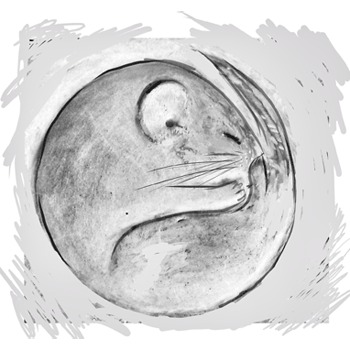
Posh Name: Muscardinus avellanarius
Diet: Dormice eat flowers, pollen, fruit, nuts and little insects. They particularly like hazelnuts, honeysuckle, bramble and oak.
Habitat: Woodland with plenty of scrub and undergrowth, with lots of places to hide!
Lifespan: Dormice live to be much older than most mice; they can live up to 5 years in the wild and 6 in captivity!
Size/Weight: A grown up dormouse’s head and body are about 2 inches long, and their tail is usually the same length. They usually weigh 17g, the same as two £1 coins, but before hibernation they eat so much that they can weigh up to 40g, over two times their normal body weight!
Home: Dormice are nocturnal so they sleep in the day! They build themselves nests, usually in a hollow tree branch. Their nests are domed like little cottages, made of strips of honeysuckle bark, weaved into a ball and sometimes surrounded with leaves to make it extra warm. Dormice love their homes and don’t like to go far away from their nests, so they only build them in places where there is plenty of food available.
In the winter, dormice build themselves a new nest, deep inside hedges or on the ground where they will be warmer. They make their winter nests out of wool, leaves and grass and fill it with food just in case they wake up early from their hibernation.
Mating and Courtship: Male Dormice use calls to attract a mate, a bit like house mice. Dormice can mate between May and September, but unlike house mice the females only have one or two litters a year, usually of four babies. Once a Dormouse is pregnant she will get her nest ready and the male will go and find another mate. Male Dormice have several mates a year and they don’t help with the babies.
Babies: The babies are born blind, without any fur, like lots of baby animals. By seven days old they have grey fur, and by eighteen days old they can see and hear and have grown brown fur. Baby dormice leave their nests when they are four weeks old, and will either make a nest for themselves, or if it’s late in the year they stay with their mother to hibernate over the winter. When they leave home they are a lovely honey-colour like their parents. They are ready to have their own babies when they are a year old.
Defining Features: Dormice are tiny little mice with extra-big eyes, small ears and fluffy tails. They have big heads and cute, chubby bodies and are a warm golden-brown colour, with cream coloured bellies. They are much cuter than their rodent cousins the house mouse and the rat. The most famous dormouse comes from Alice in Wonderland. He is at a tea party with the Mad Hatter and the March Hare, and falls asleep in the teapot!
Peculiar Behaviour: Dormice hibernate from mid-October to April/May, which means that they sleep for over half the year! Before they hibernate they eat as much as they possibly can, until they get really, really fat, and then they don’t eat until they wake up again! When they hibernate their body temperature and heart rate drops by over 90%, so that they lose as little energy as possible! Dormice are very rare now but you can tell where they’ve been by the nut shells they leave behind. Unlike most rodents they eat hazelnuts before they are ripe, and instead of biting off the top of the shell like squirrels, they chew a little round hole right in the middle of the shell.
Weaponry: Dormice are very gentle creatures, but they are also very clever. They can see very well in the dark because they have such large eyes, and they search for food with their long whiskers and excellent sense of smell. They are much more agile than normal mice and spend much more time climbing in trees and bushes than crawling on the ground. This makes them harder to find and keeps them safe from predators. Dormice are friends with the trees and bushes that keep them safe. In the spring they eat the flowers and then carry pollen on their whiskers onto other trees, helping pollination.
Vulnerability: Dormice are very small and would make a tasty snack for any predator that could find them, but they are very rare now. In the old days when England was covered in big forests and people cut trees and hedges down by hand, leaving the small trees to grow back, dormice were very common because they had lots of places to live. Now most big forests have been cut down or split into smaller forests and dormice can’t find enough food or places to build their nests. Dormice don’t like to live without their friends the trees, so it’s important that we protect places like Towerhouse Wood.
The little mouse by name of dor
Deigns not to walk upon the floor
Rather, like a bird or bee
She climbs about quite nimbly
She likes to feast on fruit and flowers
She sleeps away the daytime hours
At night she wakes, unfurls her ears
Songs of moon and stars she hears
But when the morning sun shines bright
Our little mouse of dor sleeps tight
She curls up safe inside her tree
And contemplates eternity.
(Jess)
» Badger
» Buzzard
» Dormouse
» Fox
» Hedgehog
» Mouse
» Otter
» Raven
» Robin
» Roe Deer
» Squirrel
» The Green Man
» Weeny
Unlike all other mouses
Prefers to live in doors than houses
It loves to live in doors a lot
It sleeps inside the letter slot
Because the thing it likes the most
Is to open other people’s post
(Chris White)

